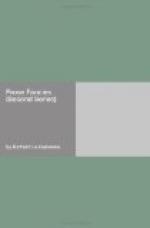not ‘all the blue’ or ‘all the brown,’ though some of us, it is true, are condemned to wear our hair brown or blue-black. But such are only unhappy exceptions. Yellow or gold is the rule. The bravest men and the fairest women have had golden hair, and, we may add, in reference to another distinction of the colour we are celebrating, golden hearts. Hair at the present time is doing its best to conform to its normal conditions of colour. Numerous instances might be adduced of its changing from black to gold, in obedience to chemical law. ’Peroxide of hydrogen!’ says the cynic. ‘Beauty!’ says the lover of art.
And it might be argued, in a world of inevitable compromise, that the damage done to the physical health and texture of the hair thus playing the chameleon may well be overbalanced by the happiness, and consequent increased effectiveness, of the person thus dyeing for the sake of beauty. Thaumaturgists lay much stress on the mystic influence of colours; and who knows but that, if we were only allowed to dye our hair what colour we chose, we might be different men and women? Strange things are told of women who have dyed their hair the colour of blood or of wine, and we know from Christina Rossetti that golden hair is negotiable in fairyland—
’"You have much gold upon your head,”
They answered all together:
“Buy from us with a
golden curl."’
Whether Laura could have done business with the goblin merchantmen with an oxidised curl is a difficult point, for fairies have sharp eyes; and, though it be impossible for a mortal to tell the real gold from the false gold hair, the fairies may be able to do so, and might reject the curl as counterfeit.
Again, if in the vegetable world green almost universally colours the leaves, yellow has more to do with the flowers. The flowers we love best are yellow: the cowslip, the daffodil, the crocus, the buttercup, half the daisy, the honeysuckle, and the loveliest rose. Yellow, too, has its turn even with the leaves; and what an artist he shows himself when, in autumn, he ‘lays his fiery finger’ upon them, lighting up the forlorn woodland with splashes—pure palette-colour of audacious gold! He hangs the mulberry with heart-shaped yellow shields—which reminds one of the heraldic importance of ’or,’—and he lines the banks of the Seine with phantasmal yellow poplars. And other leaves still dearer to the heart are yellow likewise; leaves of those sweet old poets whose thoughts seem to have turned the pages gold. Let us dream of this: a maid with yellow hair, clad in a yellow gown, seated in a yellow room, at the window a yellow sunset, in the grate a yellow fire, at her side a yellow lamplight, on her knee a Yellow Book. And the letters we love best to read—when we dare—are they not yellow too? No doubt some disagreeable things are reported of yellow. We have had the yellow-fever, and we have had pea-soup. The eyes of lions are




